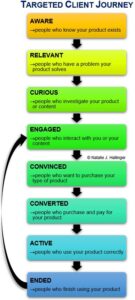Snag Your First Paying Client
as an Independent Consultant – Part 5
Building on the initial engagements in Parts 2 to 4, we now look at steps in the Client Journey that progress toward conversion. When you have successfully generated curiosity about your product, potential clients want to dive into your work to develop confidence in your expertise. A beautiful relationship is now forming based on the interactions between you and the potential client. You can help this relationship bloom with meaningful content that adds context to your basic pitch.
First Clients Strategy #4
Engage Leads with Meaningful Content
Potential clients want evidence of your expertise and that they can trust you. Complimentary content is a great way to display your expertise, approach to the work, and communication style. This reduces the time you need to spend proving your depth of knowledge to potential clients. Content can include blogs, social media posts, website pages, e-books, presentations, newsletters, white papers, or any other medium for sharing your knowledge.
Creating opportunities for people to engage with you and your content also builds up a personal relationship. Potential clients go beyond simply ‘receiving information’ and choose their own unique pathway to ‘collect information’ about your product. While they can move directly from the Curious step to the Convinced step, a deeper, longer-lasting rapport comes from the time they spend engaging you prior to purchase. Pave the way with meaningful content to maximize the impact of their self-guided investigation.
1. Create a content strategy
Again, no need to write a book. At the very least, create an outline or bulleted list.
Identify which content outlets (ie. personal blog, business website, newsletter, etc.) are frequented or preferred by your target customer.
For each outlet, determine what type of information your target customer normally consumes there. Awareness building, knowledge sharing, skill boosting, demonstrations, reviews, etc.
For each outlet, choose the most critical outcome you want from the posts. What specific action do you want readers to take after exposure to your post? Engage with post, reshare post, contact you, or visit website?
For each outlet, decide on a posting frequency that you can stick to.
Create or update your profile on those sites to reflect your business focus.
2. Create posts on critical or interesting topics related to your work
Ideas for topics: popular issues in your industry, foundational basics for newcomers, tips and tricks for common problems, thoughts on others’ posts, survey results or findings, helpful resources or tools, etc.
Post structure: one idea for how to quickly create a post is writing coach Matt Barker’s H.I.S. Method:
|
3. Publish to blog or social media profiles associated with you or your business
Draft a post and get it published as soon as possible. Wordsmithing and editing for days on end will never make it perfect. Quickly review for typos and impactful content, then get it out there.
Afraid you missed something? Good! In a few weeks, draft a follow-up post to share the new piece. It is completely human to make mistakes or discover new information. Being open with your audience makes you more relatable.
Bonus: you just created an easy opportunity for new content!
4. Post teasers on multiple platforms to attract traffic to your main presence
Every platform has character limits and typical expectations for length of posts. Use that to share simplified versions of your post that links back to the full-length article.
Ideally, the main article is on your own website or blog. Teaser versions should be on other platforms that encourage the reader to visit your site/blog/location or call you for more detailed information.
5. Track and analyze the content performance
Keep records of which platforms yielded desirable outcomes. What kind of content resonated with your audience? How does this inform your content strategy for the future?
-
-
- Part 1 – Targeted Client Journey
- Part 2 – First Clients Strategy #1: Get Client Referrals from Your Network
- Part 3 – First Clients Strategy #2: Get Work or Testimonials from Past Employers and Coworkers
- Part 4 – First Clients Strategy #3: Get Leads from Fresh Outreach
- Part 5 – First Clients Strategy #4: Engage Leads with Meaningful Content
-


Comments are closed, but trackbacks and pingbacks are open.